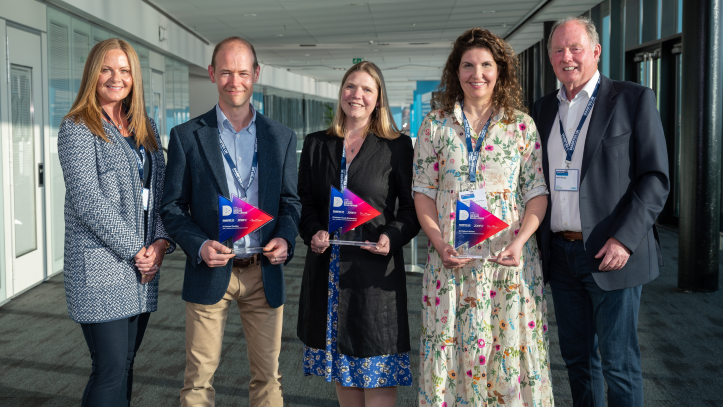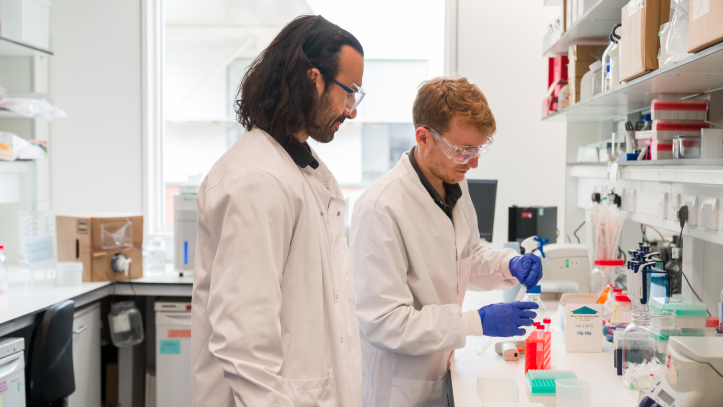In type 1 diabetes, the immune system mistakenly attacks and destroys the insulin-producing beta cells in the pancreas. To cure type 1 diabetes, we need to restore the pancreas’s ability to make insulin and stop the immune system from doing any further damage.
Researchers across the world are making exciting strides towards these goals. To speed up progress, we’re delivering the Type 1 Diabetes Grand Challenge in partnership with the Steve Morgan Foundation and Breakthrough T1D.
This bold £50 million research initiative – made possible by a landmark gift from the Steven Morgan Foundation – aims to accelerate the development of new treatments and cures for type 1 diabetes.
We say ‘cures’ because type 1 diabetes isn’t the same for everyone. A mix of genetic, environmental and immune factors shapes how the condition develops and progresses in each person. So, there is unlikely to be a one-size-fits-all solution that’s equally effective for everyone.
The Type 1 Diabetes Grand Challenge is focused on three key research areas with the greatest potential to transform lives.

Replacing and restoring beta cells
To reach a cure for type 1 diabetes, we need to bring back lost beta cells so that people with type 1 can make their own insulin again.
One treatment already available for some people who have severe hypos and no hypo awareness is islet cell transplantation. This involves transplanting cells taken from a donor pancreas. It’s helped some people with type 1 reduce or temporarily eliminate the need for insulin therapy. But it isn’t a cure.
The donor cells can’t survive in the long term. They are attacked by the immune system and struggle to get the oxygen and nutrients they need once inside the body. Plus, there’s a very limited supply of donor cells. To solve this, scientists have turned to stem cells, which they can manipulate in the lab to become beta cells.
Current clinical trials
Early clinical trials of these lab-made beta cells are already underway. One of the furthest-along treatments comes from a company called Vertex.
Vertex have been testing its beta cell replacement therapy, called zimislecel, in 12 people with type 1 who have severe hypos and no awareness of them. Results so far are exciting. After one year, the transplanted cells were still producing insulin, and 10 of the 12 participants have stopped insulin therapy completely.
However, the treatment does require immunosuppressive drugs to prevent the body from rejecting the new cells, which can come with serious side effects.
Vertex has now moved zimislecel into a bigger phase three trial, which will involve more people, followed by a longer period. If all goes well, they hope to apply for regulatory approval in the US in 2026.
Another approach comes from Sana Biotechnology. They’ve been testing gene-edited donor cells designed to be invisible to the immune system.
In 2025, they announced results from the first person to receive a transplant of these modified cells. Four weeks in, the cells were still alive and producing insulin – without the need for immunosuppressive drugs.
Finally, a team of researchers in China has taken a third route. They’ve grown new beta cells from a person’s own stem cells and transplanted them back into that same person. Because the cells come from their own body, they’re less likely to be rejected by the immune system.
In 2024, the team reported results from the first person to receive this transplant. After 10 weeks, they were producing enough insulin to stop insulin injections. A year later, they were still producing their own insulin, and their blood sugar levels were in range for 98% of the time.
These studies are all still early, but they are a big step forward. For the first time, scientists are showing that it’s possible to restore the body’s own insulin production – giving us a glimpse of what a future cure could look like.
The next few years will be critical as researchers continue testing how safe and effective these approaches are in a more general group of people with type 1 diabetes.
Boosting beta cells
The Type 1 Diabetes Grand Challenge is building on global progress to take the next leap in perfecting beta cell therapies and bringing them closer to real-world use.

With over £16 million of funding, 10 teams are running trailblazing projects to:
- improve the techniques used to make beta cells in the lab, so they work just as well as the real thing
- protect beta cells after transplants, to ensure they survive the hostile environment inside the body and the immune system’s attack
- regenerate beta cells, by discovering drugs that encourage surviving beta cells to replicate directly in the pancreas, or convert other pancreas cells – like alpha cells – into insulin producers.
Stopping the immune attack
To make sure transplanted beta cells survive, or people’s own cells aren’t attacked in the first place, researchers need to tackle the root cause of type 1 diabetes – the immune system’s attack.
That’s where a type of treatment called immunotherapy comes in. Immunotherapies change how the immune system behaves, helping to stop, slow, or potentially prevent it from destroying beta cells.
The world’s first immunotherapy, called teplizumab (or tzield), was licensed in the UK in 2025. It’s designed for people in the early, symptomless stages of type 1 diabetes. By calming down attacking immune cells before too many beta cells have been damaged, teplizumab can delay the development of type 1 diabetes and give people extra years before they need insulin therapy.
Immunotherapies are also being tested when people have just been diagnosed with type 1 diabetes, and up to 30% of their beta cells may still be alive and making insulin. So far, 11 different types of immunotherapies – which all take a slightly different approach to retrain the immune system – have shown promise in clinical trials to protect surviving beta cells at this stage.
Scientists are working to gather the evidence necessary to see more immunotherapies made available for people with or at risk of early-stage type 1 diabetes – and to make them more precise, durable, and effective.
Through the Type 1 Diabetes Grand Challenge, researchers are digging deeper into how exactly the immune attack unfolds, paving the way for new and more targeted treatments.
They’re also exploring ways to make promising immunotherapies more effective, for more people – whether that’s finding the optimal time of day to give them, or combining two immunotherapies for a boosted effect.
New insulin treatments
Stopping the immune attack and restoring beta cells remains the ultimate route to curing type 1 diabetes. At the same time, better insulins – that more closely mimic how the body’s own insulin works – could offer a functional cure, giving people safe blood sugar levels without constant intervention.
Researchers are developing ways to make taking insulin simpler – like skin patches or tablets – as well as reimagining insulins, so type 1 diabetes management becomes effortless.

In the Type 1 Diabetes Grand Challenge, research teams are focusing on:
- ultra-rapid insulins that respond more quickly to rising blood sugar levels, reducing spikes and bringing a fully closed-loop system closer
- ‘smart’ insulins that activate when blood sugar levels are high and deactivate when they drop too low
- insulins combined with another hormone that raises blood sugar, helping to fine-tune glucose control.
By driving breakthroughs in beta cell therapies, immunotherapies and novel insulin treatments, the Type 1 Diabetes Grand Challenge is uniting every strand of research needed to cure type 1 diabetes.
